Today we're going to take another look into the weird, wild world of pre-WWI Austro-Hungarian military firearms. Let's meet today's contestant.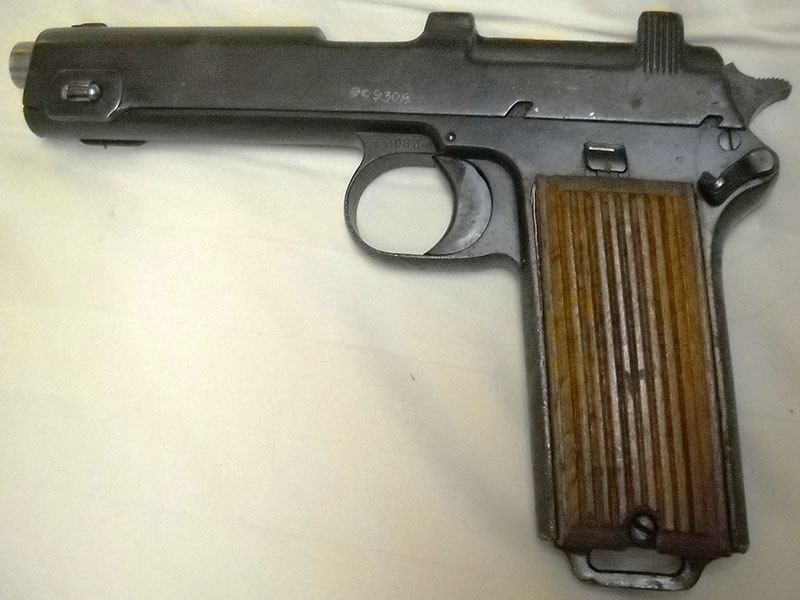
This is... well, it depends on whom you ask and when. It was commercially marketed as the Steyr Model 1911, but was adopted by the Austro-Hungarian Army as the M1912... despite the fact that said adoption took place in 1914. And that is just another of the many reasons why you will never understand the way they did things in the Austro-Hungarian Empire.
(Also, for bonus fun, "Steyr" wasn't the name of the company at that point; officially it was ŒWG, Österreichische Waffenfabriksgesellschaft ("Austrian Arms Factory Company"). Everyone called it "Steyr-Mannlicher", because it was located in the district of Steyr-Land, Upper Austria; and because it was best known for the work of its most famous engineer, the by-then-late Ferdinand von Mannlicher, who died in 1904.)
The pistol pictured above is commonly known... by none of those names. Most people nowadays call it the "Steyr-Hahn". This is because, as you can see, it has a hammer (in German, Hahn), and the previous large pistol Steyr made for the Austrian Army, the Roth-Steyr M1907, was striker-fired. Except the Roth-Steyr M1907 wasn't really called the Roth-Steyr M1907, it was the Roth-Krnka M.7, and the only association Steyr had with it was that the Austro-Hungarian government gave them the plans and ordered them (and FEG in Budapest, of whom we have heard before in these pages) to start production, because the original developers didn't have an actual factory. A familiar story! Although at least the government paid Roth and Krnka for the design.
Austria!
Sorry, bit of a digression. That's gonna happen a lot with Austro-Hungarian guns, I'm afraid. I would love to do a whole writeup on the Roth-Krnka M.7, in no small part because I would love to have a Roth-Krnka M.7, but at the moment I don't. They're a bit rarer and more valuable than M1912s and the right one hasn't come along yet. In the meantime, C&Rsenal did a big ol' video on it last year! Enjoy.
Anyway! The M.7 was the M1912's predecessor in Austro-Hungarian service, and it was striker-fired and commonly identified (in the Austrian end of the empire, anyway) with the Steyr works, so I guess the M1912's hammer was its most obvious distinguishing feature.
Also: after his collaboration with Roth, the designer of the M.7, Czech engineer Karel Krnka, went to work for: ŒWG! Guess what his next project was.
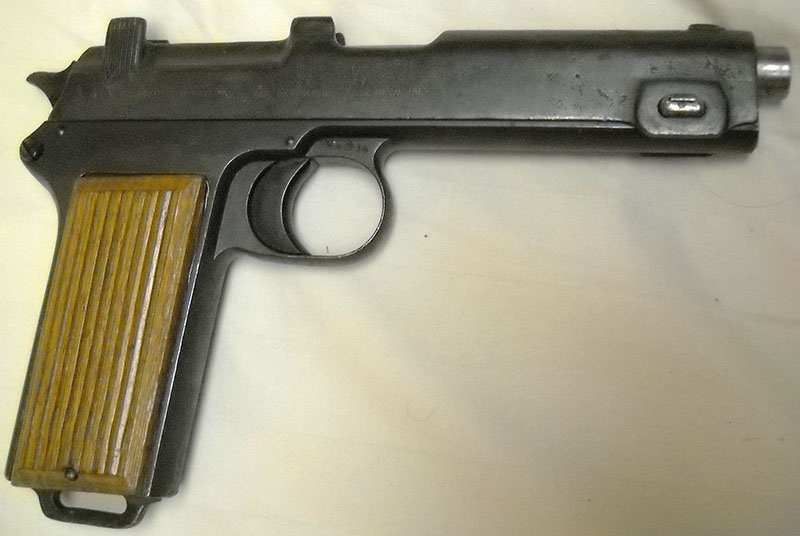
(There is—let's not all act surprised at once—some question as to just how involved Krnka was in the M1912's development. Parts of its design are obviously his work, based on their similarity to bits of the Roth-Krnka M.7, but other features are clearly cribbed from the work John Browning was doing for FN in Belgium at the time, and some accounts give most of the credit for the final distillation of the design to ŒWG's chief engineer, Konrad Murgthaler. Muddying the waters further, some of the Roth-Krnka's features were descended from the work of one Wasa Theodorovic, who worked with Roth on an unsuccessful series of long-recoil pistols before Krnka joined the concern—some of whose innovations would also turn up in the long-recoil pistols credited to Rudolf Frommer over at FEG! Oh, Austria-Hungary, how I love you.)
As noted above, the M1912 is so called because it was adopted for issue by the Austro-Hungarian Army. In practice, it seems only to have been issued to the Austrian part of that weirdly constituted double empire's forces; the Royal Hungarian Army at the same time was using FEG's much smaller Pisztoly 12M, known in its civilian guise as the Frommer Stop.
The M1912 was at least partly intended to address some of the M.7's odder features. It replaces the earlier pistol's sorta-double-action-only striker with a single-action hammer, which makes the trigger pull shorter, lighter, and generally crisper. It also offers a much simpler takedown procedure, without the M.7's two separate opportunities to launch parts across the room under spring pressure, which presumably made maintenance more agreeable. And it chambered a larger, more powerful cartridge than its predecessor's 8mm Roth—9x23mm Steyr, which was just a bit less powerful than 9mm Parabellum (although physically longer).
In addition, it's much easier and cheaper to produce than the M.7, which is hilariously complicated and has a frame that must have been about the hardest thing to machine that anyone had ever designed up to that point. I'd love to see the process sheet for machining an M.7 frame, it must be at least a dozen pages long.
One quirk of the earlier design that didn't change for the M1912 was its fixed magazine. At a glance, it looks like it ought to have a detachable box magazine in the grip, but it doesn't. Like a number of other early automatic pistols (the best-known example being the broomhandle Mauser), the M1912 is charged from above using stripper clips—for which there is a handy guide machined into the ejection port on top, as can be seen in this slightly wonky top view:

The slide locks open when empty, and after you finish thumbing a new clip's worth of rounds in there, you hit that handy button on the left side of the gun (positioned for the thumb of a right-handed shooter) to close it and chamber the first round.
So, you may be wondering, how do you get unfired rounds out of the gun if you don't want to fire them, or (rather unsafely) pump them through the action one at a time? Well, that button puts the "fun" back in "function" in another way. Note the notches in the slide on the left-side view—those have the same function as the slide notches on John Browning designs like the Colt 1903 Pocket Hammerless and the Hi-Power. If you put the safety on while the slide is open, it will stay open even if you hit the slide release button. But that doesn't mean the button then does nothing: It also disengages one of the magazine's integral feed lips, causing whatever rounds are still in there to come spewing out of the ejection port in a whimsical and amusing fashion! Aficionados call this the Bullet Fountain mode.
Let's take it apart!
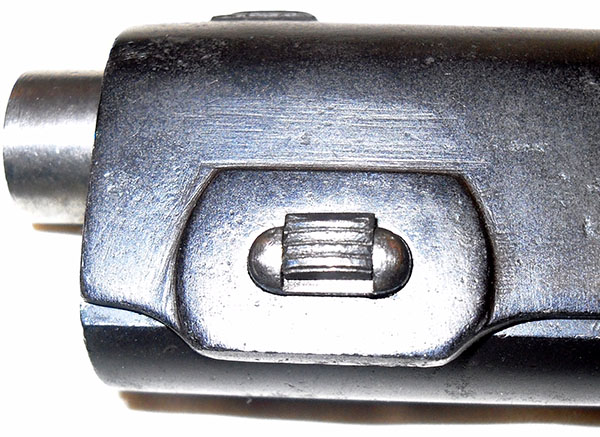
Does this thing look familiar? It should. It's a rectangular crosspin or wedge with a spring-steel catch on it. A very similar device was used to retain the barrel/cylinder assemblies on early Colt open-top revolvers, like for instance the 1851 Navy.
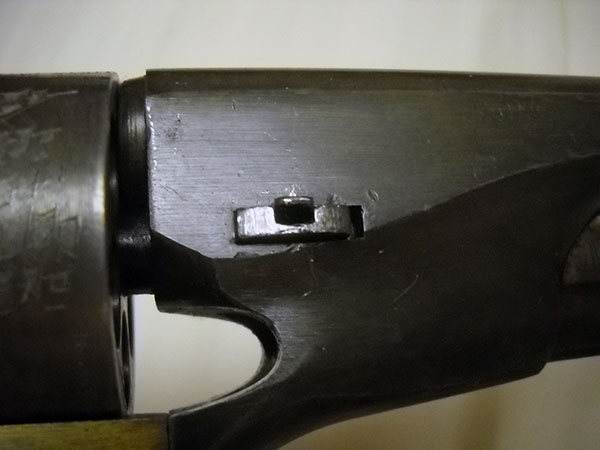
In the Steyr M1912, that device is being put to a multiple use that I personally think is quite clever. You know how in a lot of auto pistols, keeping stuff from flying apart during disassembly can be a problem, because so many things inside the works are under spring pressure? Well, it's not a problem with the Steyr at all, because of what that wedge does besides holding the slide on. This can pretty easily be seen when the action is locked open.
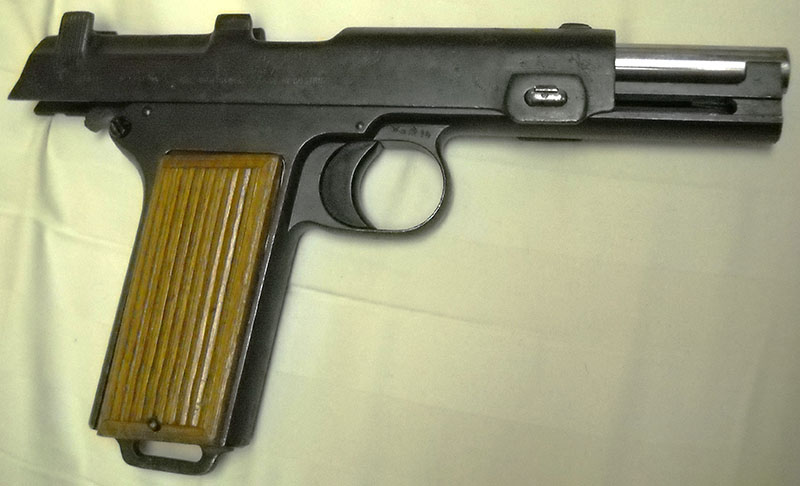
See the slot in the frame below the barrel? The recoil spring is in there, and what's actually compressing it when the slide is back is that crosspin. Which means when you take it out, all the spring tension is removed from everything.
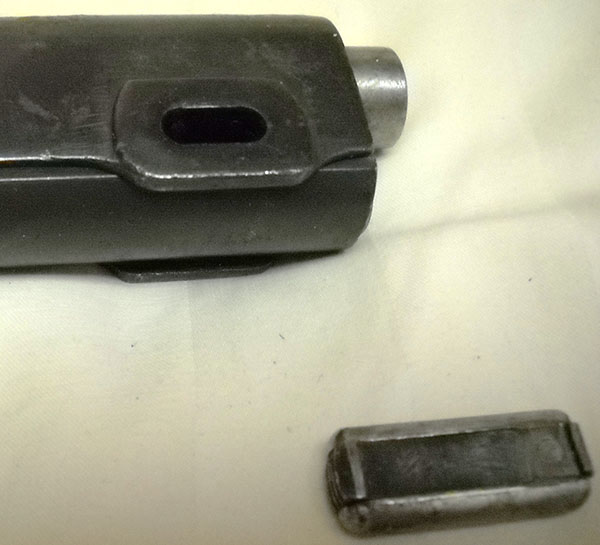
The spring is just in there, fully extended, no longer connected to anything, and you just... take the slide off. No muss, no fuss, nothing flying off. As for the barrel, it isn't physically attached to anything at all, so once the slide is removed it just lifts right off the frame.
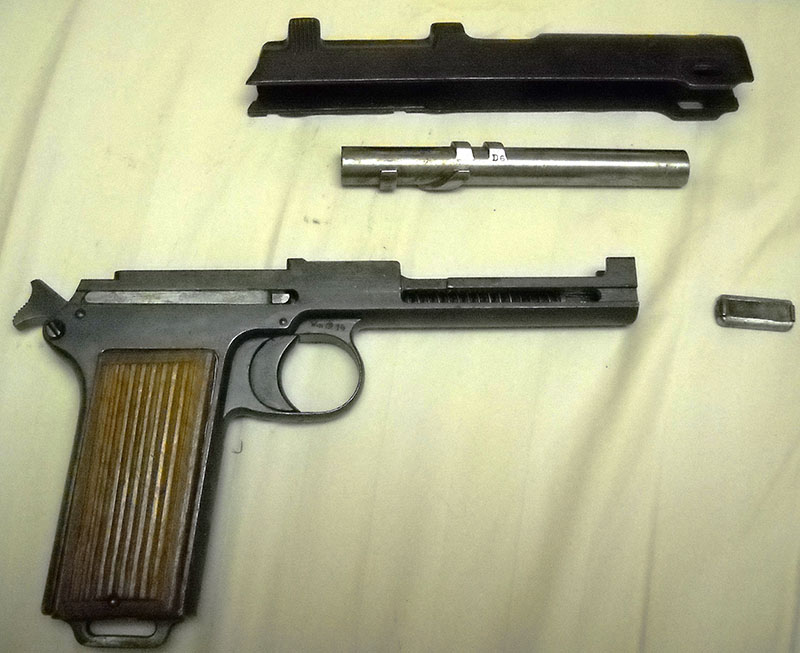
Here's a closeup of the spring channel on the frame after the pin and slide have been removed.
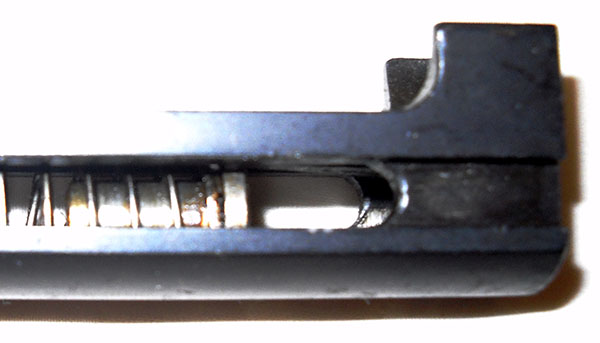
It's not a perfect design, in that it introduces that bugbear of the engineer's life, a single potential point of failure. On the other hand, a good many firearms have one item holding their actions together, such that if that one item fails, something catastrophic is going to happen. The Browning Hi-Power, for instance, has its combination slide release/diassembly pin. Lose that, and the recoil spring will push the barrel-slide assembly right off the front of the gun. (Which is a problem, but better than having it come off the back...)
At first glance it seems like the crosspin/wedge/whatever you want to call it on the Steyr is a bigger vulnerability because it's also part of the operating mechanism, but really, once the thing holding the gun together has failed, it really is kind of academic if it also did something else when the gun was together. Anyway, it's a substantial piece of metal, designed to stand up to the forces it's exposed to in the course of doing its job, and those forces are acting perpendicular to the ones required to remove it, so it's not very likely to come out of there by accident.
Another advantage of this system is that the recoil spring is captive within the frame, so not only is it not going to propel anything into an inconvenient corner of the room during disassembly, you're not likely to lose it, either. I suppose if it broke, that would make it harder to replace, but again, if your pistol's recoil spring breaks, chances are you've got bigger problems.
The hammer and trigger works are nothing spectacular, just a regular old single-action hammer-fired ignition system. The action of the slide cocks the hammer, et cetera. There is a manual safety lever which, as previously noted, also acts as a Browning-style manual slide lock. Note that (as if often the case with single-action autos) there is no decocker, so to lower the hammer without firing, you have to hold it with your thumb, pull the trigger, and let it down. This is not safe to do with a round in the chamber, but particularly not so with this pistol, as the hammer spring is quite stiff and the spur on the hammer is not very large. It's pretty easy to have it get away from you. I also don't know whether it would be safe to carry with the hammer down on a loaded chamber anyway—often that is not the case with single-action, um... actions.
As it is impossible to load this pistol without chambering a round (unless you want to carry it around with the slide open, which, you don't), I assume that means it was intended to be carried with the hammer cocked and the safety engaged, unless Austrian military doctrine called for it to be carried completely empty until required, which doesn't strike me as all that likely.
Operationally, this is a short-recoil semiautomatic pistol with a rotating barrel lockup—the same principle that modern bigger-than-blowback Berettas work on. The barrel moves backward with the slide for a short distance, then rotates as the helical lug on the underside meets surfaces inside the frame; this unlocks it from the slide. The other lug on the underside meets another surface in the frame a sort distance farther on; this stops it from further backward travel, permitting the slide to continue on without it, extract and eject the case, and so forth.
Here is a closer view of the inside of the frame, which shows the slanted slot for the rotating lug and, to its left, the traveling space for the barrel stop.

And the corresponding view of the barrel underside, with the stop and rotating lugs.

Note that the barrel appears to be serialized, and its number is different from the pistol's. I'm not certain whether that means this is not this pistol's original barrel, or if the barrels had a separate serial number range (which does sometimes happen). Probably the former. A lot can happen in 103 years.
Turning the barrel over, the locking lugs on top can be seen.

A look up inside the slide shows where they lock into, with the angled channels designed to let them rotate out of lockup as the barrel turns.
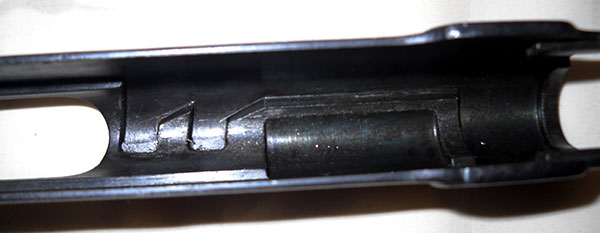
This is a stronger action than the 9mm Steyr cartridge really needs, which is why some of these pistols could later be rebarreled for 9mm Parabellum without a problem.
Putting an M1912 back together is slightly more of a faff than taking it apart, mostly because there are a couple of tiny things you have to do to get it to work that are not intuitively obvious. For example, once you've lined up the lugs on the front slide tabs with the spring track, you have to push the back of the slide down slightly past where it naturally stops (depressing the hammer spring back a bit beyond full cock) in order to line the rear rails up properly. Also, once the rails are engaged and the slide is moving forward, you must depress the slide release/Bullet Fountain button (I think to make sure the extractor lines up with its slot in the breechblock, not sure exactly what's happening inside at that step). Finally, the barrel must be in its fully retracted position, otherwise the locking lugs on the slide won't engage correctly.
If you know all of that, though, or once you've figured it out, it goes back together without a fight, and you can pop the crosspin back in and be good to go. The pin/wedge can go any which way it fits, though it's easier to get out again if you put it in with the spring tab up. (Doesn't matter at all which side you start from, as far as I can tell.) Rack the slide to make sure of proper functioning, drop it again with the button, lower the hammer, and you're back at the start.
(By the way, you shouldn't ever store a firearm with the action cocked if you can avoid it; it's bad for the hammer/striker spring. Only in the rare cases where dry firing is even worse for the gun, and there's no way of decocking the action without doing so, should this be done.)
Ergonomically, one must admit that this is not one of the greatest hits. The grip is at a rather weird angle by modern standards and pretty blocky, and the hammer spur is quite small. Also, the sights are surprisingly pathetic, more the kind of thing I would expect to find on a pocket automatic of a similar vintage than a full-size service pistol adopted by a major army. The front sight is a tiny nub (admittedly, this specific one may be worn down), and the rear sight notch is, well...
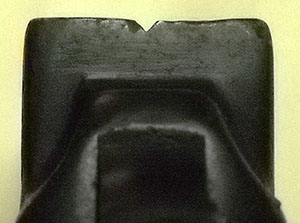
... shall we say lacking?
Then again, I suppose it should be borne in mind that the M1912, like its predecessor, was mainly intended as a sidearm for cavalry, and an early-twentieth-century European cavalryman's sidearm was a tertiary weapon. If you were an Austrian cavalryman in 1912, and you lost your carbine and your saber got broken, maybe you'd haul out your pistol, if you didn't have any better ideas. At that point you were probably at swordfighting range anyway, so it really didn't make a hell of a lot of difference if that pistol had crappy little sights. On the other hand, it's odd that the same services which routinely put such hilariously optimistic sights on rifles neglected them almost entirely on handguns.
As to markings, the M1912 didn't have many, and the one I have has even less. As with some of the other older and odder pieces in my collection, my M1912 is a bit of a beater. It's been refinished at some point in its life, which, while decently done, has lowered its collector value to the point where it was within easy reach. (Gun finish is one of those things like on Antiques Roadshow, where the man tells the old lady the plate would be worth more if she hadn't glued it back together. If you have a collectible gun that has 5% of its original finish remaining, odds are it will retain more collector value than if it has been perfectly, professionally refinished.)
Whether the refinishing did it, or simply the wear that occasioned the refinishing in the first place (I'm guessing the latter), most of this Steyr's original markings have been obliterated. There are no legible markings on the lefthand side of the slide at all. It ought to say "M.1912" and "Steyr {year of manufacture}" on the left side, if it's a military gun, or have a longer engraving of the full manufacturer's name if it was originally made for commercial sale, but there's nothing at all. The left-side serial number survives (the frame markings were struck much deeper than the lettering on the slide). For some reason, someone felt the need to (quite sloppily) electropencil a similar, but not identical, number on the slide, sometime after the gun was refinished.
I do know that this particular one was made in 1914, and I know that because the Austrians dated their proof marks. The proof marks on these guns were on the right side of the trigger guard web, and like the serial number on the left side they were much more deeply struck than the rest of the markings, so the one on mine are still perfectly clear.
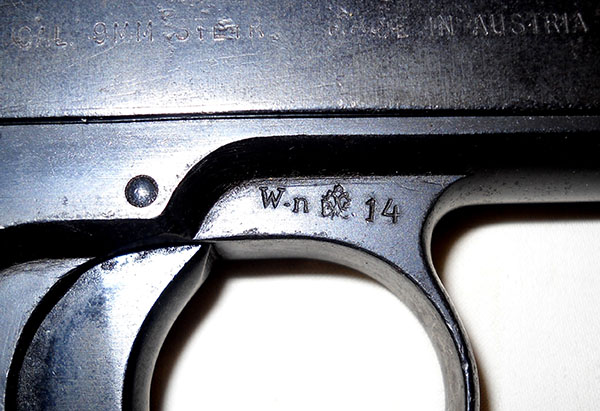
This shows that this pistol was originally proofed in Vienna (W—Wien), for nitrocellulose propellant (i.e., "smokeless" powder), in 1914. That indicates it was made for the original military contract, as the commercial ones weren't made until after World War I, and their proof marks were different (the Wn{eagle}XX type doubles as a military acceptance mark).
Steyr M1912s made for the army contract were serialized in blocks of 9,999 with a letter suffix added for the second and subsequent blocks. Nine is ninety-three-hundred-and-change D, indicating it was just shy of the 50,000th one made out of an eventual total of around 300,000. Interestingly, there's a bit of pitting on the left side of the slide that's right around the location and shape of the crest that was applied to the ones made for the Chilean Army, but the frame markings are not consistent with that, so either it's a coincidence, or this isn't the original slide. That's conceivable, but seems unlikely, since the Chilean ones are much rarer (ca. 5,000 made) and more valuable than the regular Austrian Army contract production.
Also visible in this shot are the remnants of some old import markings, again mostly worn off or obscured in the rebluing process. You can see where it said "Cal. 9mm Steyr" and "Made in Austria", two pieces of data required by U.S. firearms import law after 1968. There are fragments to the rear of that which were almost certainly the name and location of the importer, but they're so far gone I can't even guess at what they once said.
Austria-Hungary's defeat in World War I was the end of the empire, but not the end of Steyr, nor of these pistols. Although they had some features that rapidly became quite dated by the course of automatic pistol development after the war (such as the fixed magazine), they were robust and reliable guns, well-regarded by most of those who handled them, and they remained in demand. Steyr produced them through 1945, for commercial sale as well as export. They were used by Chile, Romania (interestingly, the Romanians bought theirs before WWI, in which they were on the other side, making the M1912 one of the relatively few guns to see official service on both sides of the war), and both of the WWII-era Italian governments (the proper one and the breakaway Fascist one erected after Mussolini was ousted from Rome). The German Army had bought a bunch of them during WWI, and the Nazis ordered a bunch more for service in WWII; the latter batch were rechambered for 9mm Parabellum, which (along with their Nazi markings) make them the most sought-after variant today.
Well, second most. The rarest and therefore presumably most sought-after (albeit by a very specialized subset of collectors) is the machine pistol version produced during World War I. This had an extended, but still fixed, magazine and was fully automatic, which must have been... exciting... to shoot. If that wasn't wacky enough for you, there was reportedly a special rig in which you could install two of these with a common trigger and shoulder stock, creating a sort of double-barrelled submachine gun. I told you the Austrians were weird. That's the kind of weapon mod that would even make the Wehrmacht go, "Whoa whoa, slow down there, cowboy." (Some accounts indicate these were intended for aircraft use, which makes a little more sense.)
Steyr would survive both world wars and (unlike, for instance, FEG, its counterpart in Budapest, which now makes air conditioners) remain in the firearms business. Their 1970s attempt at securing the Austrian amilitary sidearm contract, the GB, is best known for losing that competition to the upstart Glock 17, but is now sought-after on the American collector market for basically that exact reason. Gun collectors often have some of that indie-rock sensibility going on. Interestingly, the GB uses a gas-delayed blowback system (that's what GB stands for, the German for "gas braking"), albeit one laid out differently than the H&K-derived one in the Walther CCP. But that may be another show, someday.
Despite the failure of the GB, the company remains (and is actually named "Steyr Mannlicher" nowadays); their most famous modern product is probably the StG 77, the standard rifle of the Austrian Bundesheer, better known on the export market as the AUG. They also make an up-to-date service-type handgun range, the M series.
--G.
-><-
Benjamin D. Hutchins, Co-Founder, Editor-in-Chief, & Forum Mod
Eyrie Productions, Unlimited http://www.eyrie-productions.com/
zgryphon at that email service Google has
Ceterum censeo Carthaginem esse delendam.


 RE: Gun of the Week: Steyr M1912
RE: Gun of the Week: Steyr M1912 RE: Gun of the Week: Steyr M1912
RE: Gun of the Week: Steyr M1912
 RE: Gun of the Week: Steyr M1912
RE: Gun of the Week: Steyr M1912 RE: Gun of the Week: Steyr M1912
RE: Gun of the Week: Steyr M1912 RE: Gun of the Week: Steyr M1912
RE: Gun of the Week: Steyr M1912
 Printer-friendly copy
Printer-friendly copy


















